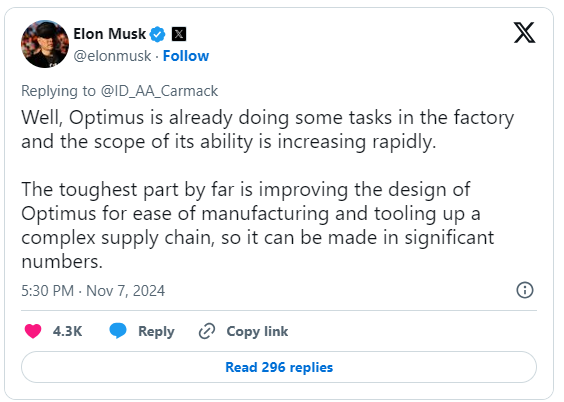There is a lot of attention on the robotics sector, specifically humanoids.
Like AI, there is a race taking place. This one could be a bit different in that we are not looking at a winner take all (or most) situation. In fact, we are dealing with what might be a near unlimited TAM.
Projects are all over the place. How many humanoid robots can we utilize? Elon Musk threw out a forecast of one for every human. Why not 2? Or 5?
Actually, humanoids exceeding humans is, in my view, dependent upon the advancements in space. Whether it is Musk with Mars, Bezos and the Moon, space manufacturing, or basic space exploration, a lot of this is going to be done without people. Space is not a friendly realm for humans.
Therefore, being able to product billions of humanoids is the task that is confronting humanity.
Tesla: Designing Optimus For Mass Scale
There was an interesting tweet (actually a response) that Elon Musk posted.

This should be an eye opener to anyone looking at the field.
It clears states the toughest part is the ease of manufacturing and tooling up a supply chain. The design of utility is not the hardest part, something that many focus upon. How many mentioned the idea of ease of manufacturing.
Here is where Tesla probably has the lead.
As Musk often alludes to, prototypes are easy, scaling is hard. Most robotics companies are likely focusing upon how to get the things to work. Naturally, this is crucial since, if the product doesn't work, scaling is meaningless.
However, we have to presume many of these companies will achieve utility with their humanoid bots. How long until that happens is up to speculation. That said, if we think about it, that is only a part of the equation.
Ease of manufacturing means scaling. This is crucial and not being discussed. The major question is how much in depth thought is going into this. From what I can see, many of the companies looking into this field, including recent entrants of OpenAi and Meta, are not manufacturers. Neither is a Boston Dynamics.
Then we have supply chain optimization. We saw how even long time manufacturers can fail at this. Automotive companies built things for more than 100 years. Yet, when the lockdowns due to the pandemic hit, their operations were hindered. Tesla, did not face the same challenges, much of it stemming from the vertical integration the company developed.
Machines Building Machines
This was always a vision of Musk.
It is all part of the exponential that we see taking place in the digital world. At some point, the same principles should enter the physical world as robots bridge the two. Here is where we see the TAM become basically unlimited.
The multiplication of skills is mind blowing. It is something that I do not think many consider. When a robot learns one skill, it is actually the system. Thus, if 100 new robots are produced with the new software, that skill is in all 100.
What happens when 100K robots are each learning a new skill. That is 100K skills that will be available on the next software update.
Of course, progress is the hardest to see in the early stages.
Look at this exponential curve.

We see, what appears, to be little progress from 0 to 2. The movement is rather significant. For our discussion, consider these skills.
If we look at 2-4, it is better, but still not overwhelming.
Things start to change when we go from 4-6. There we see things really accelerating.
Unfortunately, our chart ends at 7, which is a bigger jump from 4-6. If it went out to 8, it would really drive home the point.
What happens after 1,000 robots each learning skills daily. The entire network grows at a rapid pace. However, this is nothing compared to 100K.
The lesson here is not to be fooled by the early "leaders" with prototypes. To be truly successful, it is going to require the ability to manufacture at scale. Some of the robotic companies will outsource this, which is a wise move. That said, there is still the issue of design versus manufacturing, something always present when two different companies are involved.
It will be interesting to see when we start to see scaling of these bots. It is likely the next 18 months will still be prototyping. That means the first leg of scaling could occur at some point in 2026.
Posted Using InLeo Alpha